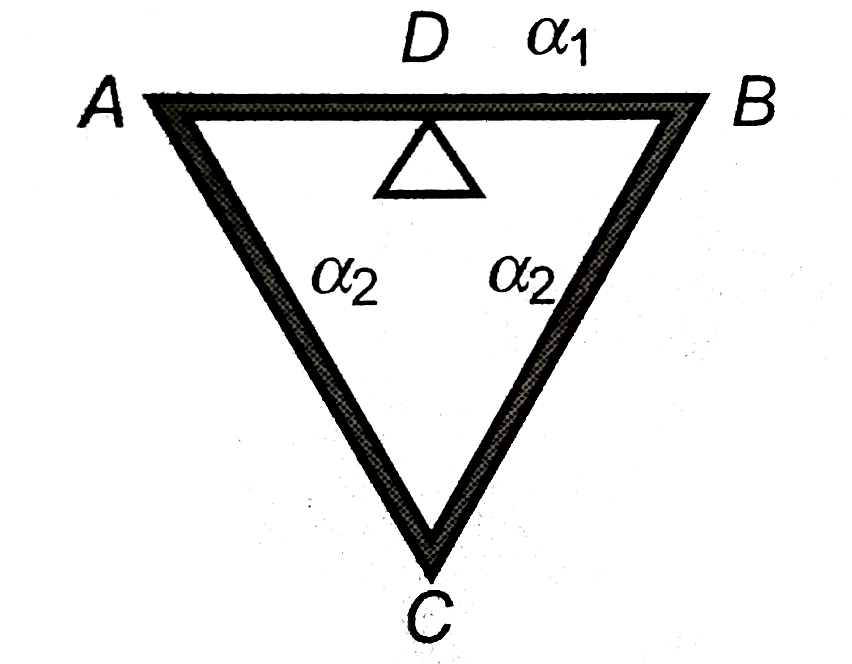Two rods , one of aluminium and the other made of steel, having initial length l1 and l2 are connected together to from a sinlge rod of length l1+l2 . The coefficient of linear expansion for aluminium and steel are αa and αs for AC and BC . If the distance DC remains constant for small changes in temperature,
αsαa
αaαs
αs(αa+αs)
αa(αa+αs)
The correct Answer is:C
To solve the problem, we need to analyze the situation involving two rods made of aluminum and steel, which are connected together. We'll denote the initial lengths of the aluminum and steel rods as l1 and l2, respectively. The coefficients of linear expansion for aluminum and steel are αa and αs.
1. Understand the Problem: We have two rods, one made of aluminum and the other made of steel. When the temperature changes by ΔT, both rods expand. We need to find the ratio l1l1+l2 under the condition that the change in length of both rods is the same.
2. Change in Length Formula: The change in length ΔL of a rod due to temperature change is given by:
ΔL=L⋅α⋅ΔT
where L is the initial length, α is the coefficient of linear expansion, and ΔT is the change in temperature.
3. Set Up the Equations: For the aluminum rod, the change in length ΔL1 is:
ΔL1=l1⋅αa⋅ΔT
For the steel rod, the change in length ΔL2 is:
ΔL2=l2⋅αs⋅ΔT
4. Equate the Changes in Length: Since the problem states that the distance DC remains constant, we have:
ΔL1=ΔL2
Thus, we can write:
l1⋅αa⋅ΔT=l2⋅αs⋅ΔT
We can cancel ΔT from both sides (assuming ΔT≠0):
l1⋅αa=l2⋅αs
5. Express l2 in terms of l1: Rearranging the equation gives:
l2=l1⋅αaαs
6. Find l1+l2: Now, we can express the total length of the combined rod:
l1+l2=l1+l1⋅αaαs=l1(1+αaαs)
7. Calculate the Ratio: Now we can find the ratio l1l1+l2:
l1l1+l2=l1l1(1+αaαs)=11+αaαs=αsαa+αs
8. Final Answer: Thus, the ratio l1l1+l2 is:
l1l1+l2=αsαa+αs
ΔL=L⋅α⋅ΔT
where L is the initial length, α is the coefficient of linear expansion, and ΔT is the change in temperature.
ΔL1=l1⋅αa⋅ΔT
For the steel rod, the change in length ΔL2 is:
ΔL2=l2⋅αs⋅ΔT
ΔL1=ΔL2
Thus, we can write:
l1⋅αa⋅ΔT=l2⋅αs⋅ΔT
We can cancel ΔT from both sides (assuming ΔT≠0):
l1⋅αa=l2⋅αs
l2=l1⋅αaαs
l1+l2=l1+l1⋅αaαs=l1(1+αaαs)
l1l1+l2=l1l1(1+αaαs)=11+αaαs=αsαa+αs
l1l1+l2=αsαa+αs
Topper's Solved these Questions
- TEMPERATURE AND THERMAL EXPANSIONBOOK - CP SINGHCHAPTER - TEMPERATURE AND THERMAL EXPANSIONEXERCISE - EXERCISES
64 Videos
- SOUND WAVESBOOK - CP SINGHCHAPTER - SOUND WAVESEXERCISE - Exercises
130 Videos
- UNITS, DIMENIONS AND MEASUREMENTSBOOK - CP SINGHCHAPTER - UNITS, DIMENIONS AND MEASUREMENTSEXERCISE - Exercises
63 Videos
Similar Questions
Two rods, one of aluminium and other made of steel, having initial lenghts l1andl2 are connected together to form a singel rod of length (l1+l2). The coefficient of linear expansions for aluminium and steel are αa and αs respectively. If length of each rod increases by same amount when their tempertures are raised by t∘C, then find the ratio l1(l1+l2).
View SolutionThe coefficient of linear expansion varies linearly from α1 and α2 in a rod of length l. Find the increase in length when its temperature is increased by ΔT.
View Solution
Knowledge Check
Two rods, one of aluminium and the other made of steel, having initial length l1andl2 are connected together to from a single rod of length l1+l2. The coefficients of linear expansion for aluminium and steel are αaandαs and respectively. If the length of each rod increases by the same amount when their temperature are raised by t0C, then find the ratio l1/(l1+l2)
A(αs)/(αa)B(αa)/(αs)C(αs)/((αa)/(αs))D(αa)/((αa)/(αs))Three rods of equal of length are joined to from an equilateral triangle ABC. D is the midpoint of AB. The coefficient of linear expansion is α1 for AB and α2 for AC and BC . If the distance DC remains constant for small changes in temperature,
 Aα1=α2Bα1=2α2Cα1=4α2Dα1=1/2α2
Aα1=α2Bα1=2α2Cα1=4α2Dα1=1/2α2Two rods of lengths L1 and L2 are welded together to make a composite rod of length (L1+L2). If the coefficient of linear expansion of the materials of the rod are α1 and α2 respectively. The effective coefficient of linear expansion of the composite rod is
AL1α1−L2α2L1+L2BL1α1+L2α2L1+L2C√α1α2Dα1+α22
An equilateral triangle ABC is formed by joining three rods of equal length and D is the mid-point of AB. The coefficient of linear expansion for AB is α1 and for AC and BC is α2. The relation between α1 and α2, if distance DC remains constant for small changes in temperture is
_E01_117_Q01.png)
View SolutionIf L1 and L2 are the lengths of two rods of coefficients of linear expansion α1 and α2 respectively the condition for the difference in lengths to be constant at all temperatures is
View SolutionThe coefficient of linear expansion varies linearly from α1 and α2 in a rod of length l. Find the increase in length when its temperature is increased by ΔT.
View SolutionTwo rods having length l1andl2 made of materials with the linear expansion coefficient α1andα2 were soldered together. The equivalent coefficients of linear expansion for the obtained rod
View SolutionTwo rods of length l1 and l2 are made of material whose coefficient of linear expansion are α1 and α2 , respectively. The difference between their lengths will be independent of temperatiure if l1/l2 is to
View Solution
